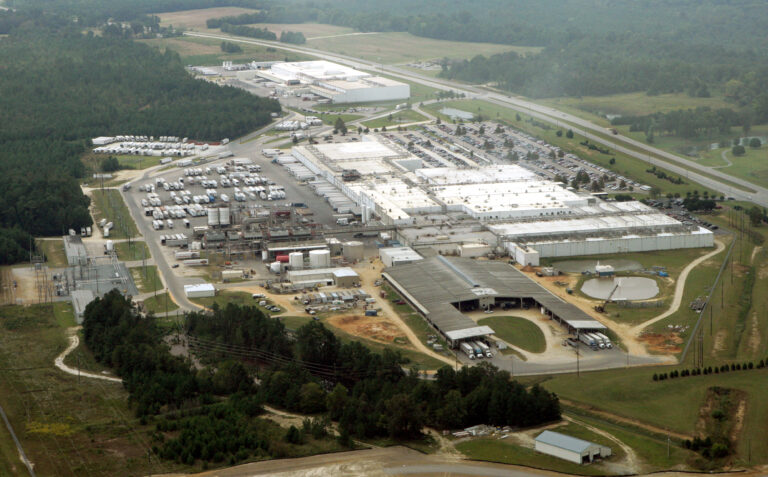EPA Proposes to Exclude Most Slaughterhouses and Rendering Plants from Updated Water Pollution Control Rules
By: Waterkeeper Alliance

Waterkeeper Alliance and other Clean Water Experts Urge EPA to Require Slaughterhouses and Rendering Plants to Comply with Modern Technology Standards for Nitrogen and Phosphorus Pollution
Tomorrow, the U.S. Environmental Protection Agency (EPA) is scheduled to publish proposed rules that would require pollution reductions from fewer than half of the 3,879 slaughterhouses and rendering plants that discharge waste to U.S. rivers, lakes, and streams. Slaughterhouses and rendering plants are the largest industrial source of phosphorus and the second largest source of nitrogen pollution that feeds algal blooms and fish-killing “dead zones” in America’s waterways. EPA’s preferred option in the regulations would cut pollution significantly from 126 of the largest plants that pipe their waste directly into waterways, but largely ignore the 3,708 indirectly discharging plants that send their waste to municipal sewage treatment plants, which are often overwhelmed and not equipped to treat the industrial waste.
“Many municipal wastewater treatment plants cannot handle the slaughterhouse and rendering facility waste they receive, likely contributing to 73% of these treatment plants violating their clean water permit limits,” said Kelly Hunter Foster, Waterkeeper Alliance Senior Attorney. “EPA must establish pollution standards for these indirect dischargers rather than allowing the industry to either pollute waterways or pass their treatment expenses off to impacted communities and citizens that cannot, and should not, bear those costs.”
EPA’s proposed rule also includes a far more protective option that could set pollution limits for 133 direct dischargers and also establish limits on nitrogen, phosphorus, and other harmful pollution from an estimated 1,485 facilities that discharge indirectly to municipal sewage treatment plants. If adopted, these standards will cut the total amount of nitrogen pollution from the industry by 83 percent (or 76 million pounds annually) and phosphorus pollution by 94 percent (or 20 million pounds).
The proposed rules are a direct response to a lawsuit filed on behalf of Waterkeeper Alliance and nine other environmental organizations in 2019 and 2022 by the Environmental Integrity Project and Earthjustice. The lawsuit demanded that EPA follow the requirements of the Clean Water Act and to modernize badly outdated technology standards for water pollution control systems for slaughterhouses and meat processing plants, which have not been updated in two decades.
Waterkeeper Alliance is among a coalition of groups demanding that EPA do more and, at a minimum, adopt the most environmentally protective alternative in the proposed rule to protect our rivers, streams, lakes, and estuaries, and to keep waste generated by slaughterhouse and rendering facilities from overwhelming public sewer systems.
EPA plans to hold an online public hearing on its proposed rules on Wednesday, January 24th and an in-person hearing at agency headquarters on January 31st. For a copy of the proposed regulations, click here.
QUOTES FROM ALLIED GROUPS:
“We are disappointed that EPA has chosen the least protective option, which is bad news for the Chesapeake region since we have far more indirect discharging slaughterhouses and rendering facilities than direct dischargers. In our region that is already suffering from nutrient pollution, the lack of limits on nitrogen and phosphorus for the majority of our plants is incredibly short sighted, especially given that the technology to do this exists,” said Robin Broder, Deputy Director of Waterkeepers Chesapeake.
“It is well past time for slaughterhouses to put in place modern pollution controls that EPA acknowledges are widely available. EPA proposes significant reductions in nitrogen and phosphorus dischargers from big slaughterhouses that pipe their wastes into public waterways, and that is welcome news. But its preferred option would allow thousands of slaughterhouses to continue to dump nutrients into public sewage treatment plants that aren’t prepared to handle them. All communities deserve relief from the slaughterhouse industry’s harmful nutrient pollution,” said Sarah Kula, Environmental Integrity Project attorney.
“EPA admits that pollution from slaughterhouses and meat processing plants disproportionately harms under-resourced communities, low-income communities, and communities of color. We applaud EPA for taking action to strengthen the outdated and under-protective water pollution control standards that govern this industry—but we urge the agency to ensure that its new standards protect the people most at risk,” said Earthjustice attorney Alexis Andiman.
“If the price of a slightly cheaper chicken nugget is dead fish, toxic algae or people getting sick from pollution, I think most Americans would say no thank you. The EPA should strengthen its proposed rule to keep more than 300 million pounds of slaughterhouse pollution out of our rivers and streams, as current technology allows,” said John Rumpler, Clean Water Director for Environment America.
“Slaughterhouses have spent decades polluting our nation’s waters with abandon, leaving taxpayers to foot the bill. EPA must seize this opportunity to rein in this dirty industry by enacting the most environmentally protective regulatory option without further delay,” said Dani Replogle, Food & Water Watch Staff Attorney.
“We are heartened that the EPA has begun the long overdue process of curbing the daily discharge of blood, fat, nitrogen and other pollutants from industrial slaughter and rendering facilities into our waters. Limiting pollution from inhumane factory farming systems will be an important step toward protecting both people and animals from this pollution,” said Rebecca Cary, special counsel for the Humane Society of the United States.
“Lax regulations allow industrial animal agriculture to profit while burdening communities with pollution and causing animals immense suffering. With these updated pollution standards, EPA is making slaughterhouses account for some of the costs of addressing their unsustainable business model,” said Larissa Liebmann, senior staff attorney for the Animal Legal Defense Fund.